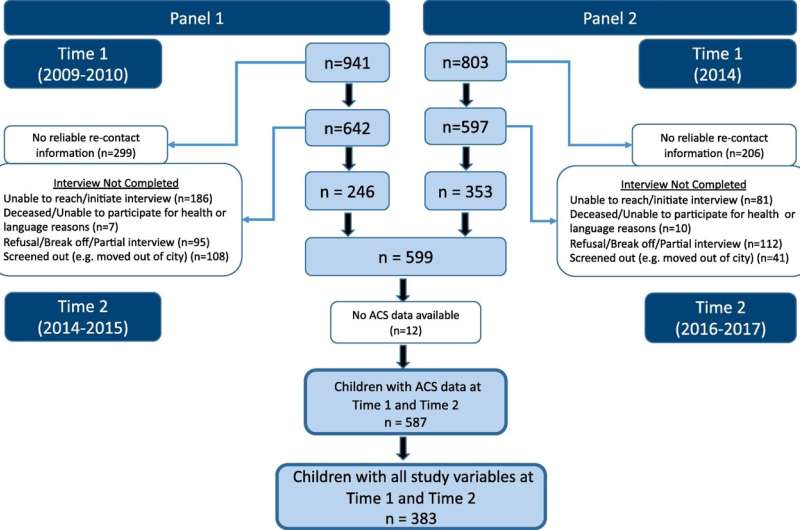Description of the study timeline and the longitudinal analytic sample: New Jersey Child Health Study (2009–2017). Abbreviations: ACS: active commuting to/from school. Credit: Preventive Medicine Reports (2022). DOI: 10.1016/j.pmedr.2022.101718
Children who walk or bike to school at a young age are more likely to continue the healthy habit as they age, according to a study co-authored by a Rutgers researcher.
"The walk to school is a wonderful moment in the day that provides children a glimpse of living an active lifestyle," said David Tulloch, a professor of landscape architecture at Rutgers–New Brunswick and co-author of the study, which was published in the journal Preventive Medicine Reports. "When people start walking early, it can have a lasting impact on their health."
In the United States, about 11 percent of children walked or biked to or from school, according to data from the National Household Travel Survey, and that rate hasn't changed in a decade.
The research team found that if children are taught early to actively commute—traveling by physical means—they are far more likely to keep doing so later in their educational career.
To measure whether active commuting persists over time, the researchers surveyed parents and caregivers about the school travel habits of their children on two separate occasions two to four years apart (baseline and follow-up) between 2009 and 2017 in four predominantly low-income New Jersey cities: Camden, New Brunswick, Newark and Trenton.
Data from 587 households was collected as part of the New Jersey Child Heath Study, which tracked children 3-15 years of age. The distance to school and other spatial factors were calculated by Tulloch and colleagues at the Grant F. Walton Center for Remote Sensing and Spatial Analysis at Rutgers.
The researchers found that more than three quarters of children who engaged in active commuting at baseline continued to do so two to four years later, while few newly took it up by the time of follow-up if they hadn't done so before. In fact, children who actively commuted to school at baseline were seven times more likely to actively commute two to four years later compared with children who didn't actively commute at baseline.
"Most kids don't achieve the 60 minutes per day of physical activity that they're recommended to get," said Robin DeWeese, an assistant research professor in the College of Health Solutions at Arizona State and the study's lead author. "Active commuting to school is one way to get more of that activity."
To promote active commuting, DeWeese suggests "schools and communities encourage active commuting during early grades as that may yield benefits even for students in higher grades."
Active commuting varied by demographic characteristics and perceptions of the neighborhood. Children with a parent born outside the U.S. had lower odds of active commuting compared with those whose parents were born in the U.S., while children of parents who perceived their neighborhood safe from crime were more than 2.5 times as likely to engage in active commuting.
The greatest and most persistent barrier was the distance between home and school, Tulloch said. Distance to school often increases as children age because middle and high schools are larger and less prominent than elementary schools. As a result, active commuting likelihood tends to decrease once children reach high school.
Smarter urban design can help reverse this trend, said Tulloch. Remote drop-offs and "walking school buses"—that is, groups of students chaperoned by volunteer parents—can encourage children to actively commute at a young age. Infrastructure improvements, such as sidewalks and tree-lined streets, can make walking more pleasant, he added.
"One of the most visited tourist sites in New York City is the High Line, a green walkable space with no cars," said Tulloch. "We should be doing this type of planning everywhere—especially in school zones."
More information: Robin S. DeWeese et al, Active commuting to school: A longitudinal analysis examining persistence of behavior over time in four New Jersey cities, Preventive Medicine Reports (2022). DOI: 10.1016/j.pmedr.2022.101718
Provided by Rutgers University
























